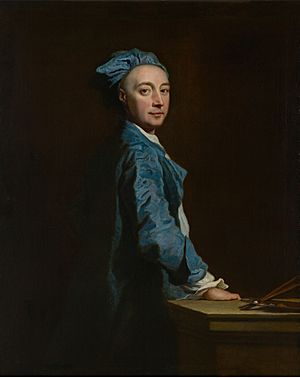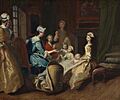Joseph Highmore facts for kids
Quick facts for kids
Joseph Highmore
|
|
|---|---|

Self-Portrait around 1746, National Gallery of Victoria
|
|
| Born | 13 June 1692 London, England
|
| Died | 3 March 1780 (aged 87) Canterbury, Kent, England
|
| Known for | Portrait painting, writer |
| Spouse(s) | |
Joseph Highmore (born June 13, 1692 – died March 3, 1780) was a talented English artist. He painted many different types of pictures. These included portraits (pictures of people), conversation pieces (group portraits that look like a moment in time), and history scenes. He also worked as an illustrator and writer. After he stopped painting at age 70, he wrote articles about art history and art criticism.
Who Was Joseph Highmore?
Early Life and Artistic Journey
Joseph Highmore was born in London. He was the third son of Edward Highmore, who sold coal. His uncle, Thomas Highmore, was a special painter to King William III. Joseph showed a gift for art from a young age. However, his family wanted him to become a lawyer instead.
So, he started training to be a lawyer. But even while studying law, he kept going to drawing classes. He also attended talks about how the human body works. When he was 17, he decided to leave his law career. He chose to become a portrait painter in London. From 1720, he attended the St Martin’s Lane Academy. Here, he learned about new French art styles.
Highmore's Travels and Later Career
In 1725, a special group called the Order of the Bath was brought back. Joseph Highmore was chosen to paint the knights in their full uniforms. In 1732, he traveled to the Low Countries (like Belgium and the Netherlands). He wanted to study the works of famous painters like Rubens and van Dyck. Two years later, he visited Paris to study art in museums and private collections.
Over the next few years, the royal family supported his work. But in the 1740s, he started painting more for middle-class people. They liked how he could capture a person's look quickly. They also liked his relaxed group paintings. In 1762, Highmore sold his art studio. He then moved to Canterbury to live with his daughter and son-in-law. After this, he wrote articles about art history. These included writings on Rubens' paintings and color theory.
Joseph Highmore passed away at 87 years old on March 3, 1780. He was buried in Canterbury Cathedral.
Family and Legacy
Joseph Highmore's wife, Susanna Highmore (her maiden name was Hiller), was a poet. However, not much of her poetry was published. His son, Anthony Highmore (1719–99), was also an artist. One of Anthony's children, also named Anthony Highmore, became a writer about legal topics and worked to help people.
Highmore's Famous Paintings
Joseph Highmore painted many different kinds of art. He created portraits, group scenes, and historical pictures. He worked for both wealthy families and middle-class people.
Portraits and Group Scenes
Highmore was very good at making group portraits look natural. They felt like a real moment in time, like a "conversation piece."
Mr Oldham and his Guests
His painting Mr Oldham and his Guests is a great example. It shows Mr. Oldham standing on the far left, with his arms crossed over a chair. He looks amused as he watches his guests, who are already sitting at a table. This painting is now in the National Gallery in London.
Portrait of Susanna Highmore
Highmore also painted pictures of his own children. His portrait of his daughter Susanna (around 1740) is very special. It shows rich details and Susanna looks confidently at the viewer. For his portraits, Highmore often hired a special artist named Joseph Van Aken. This artist would paint the clothes and costumes of the people in the portraits.
Art with a Message
Highmore also painted scenes from the Bible. He had studied this type of "historical painting" during his trip to Paris.
Paintings for the Foundling Hospital
One of his biblical paintings is Hagar and Ishmael. Highmore gave this painting to the Foundling Hospital. This hospital was a special place that helped women and children in need. The painting is now at The Foundling Museum in London.
In the 1740s, Highmore became involved with the Foundling Hospital. He showed his support through his art. His painting The Angel of Mercy (around 1746) tells a powerful story. It shows a mother facing a difficult choice. An angel stops her hand and points to the Foundling Hospital in the background. This shows the hospital as a place of hope and help.
The Pamela Series
In 1744, Highmore created a series of 12 paintings. These paintings were based on a very popular book called Pamela, or Virtue Rewarded by Samuel Richardson. Highmore's paintings were not just simple book illustrations. Instead, they told the whole story of Pamela through a series of connected pictures. His paintings focused on the characters and their feelings.
As a writer, Highmore was known for his works like Critical Examination of Reubens' two Paintings in the Banqueting House. He also wrote Observations on Bodwell's Pamphlet against Christianity.
Images for kids




